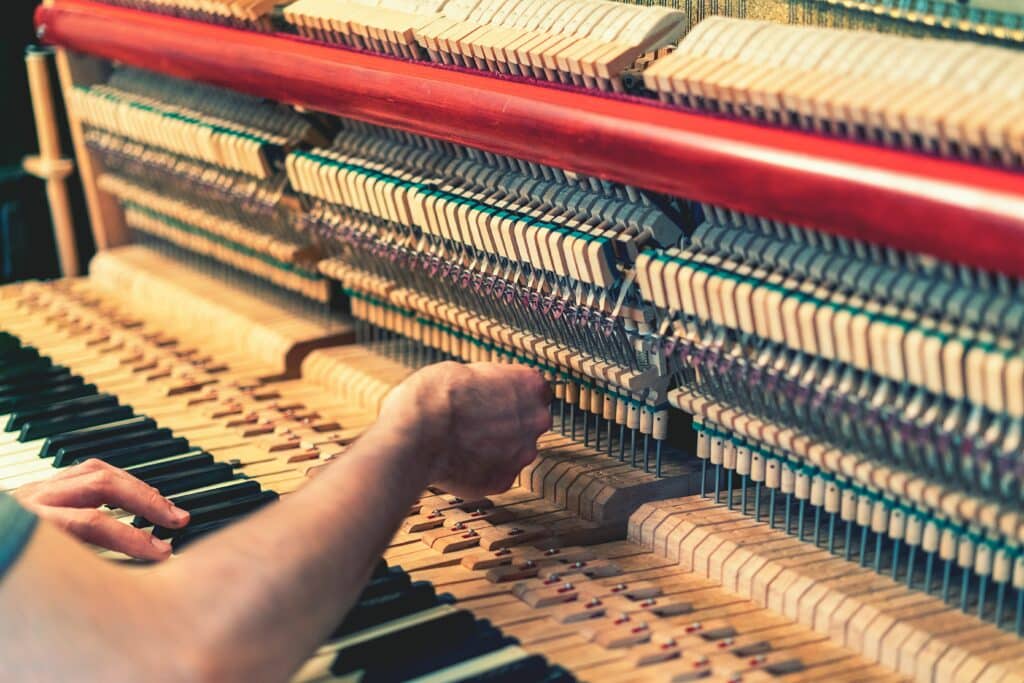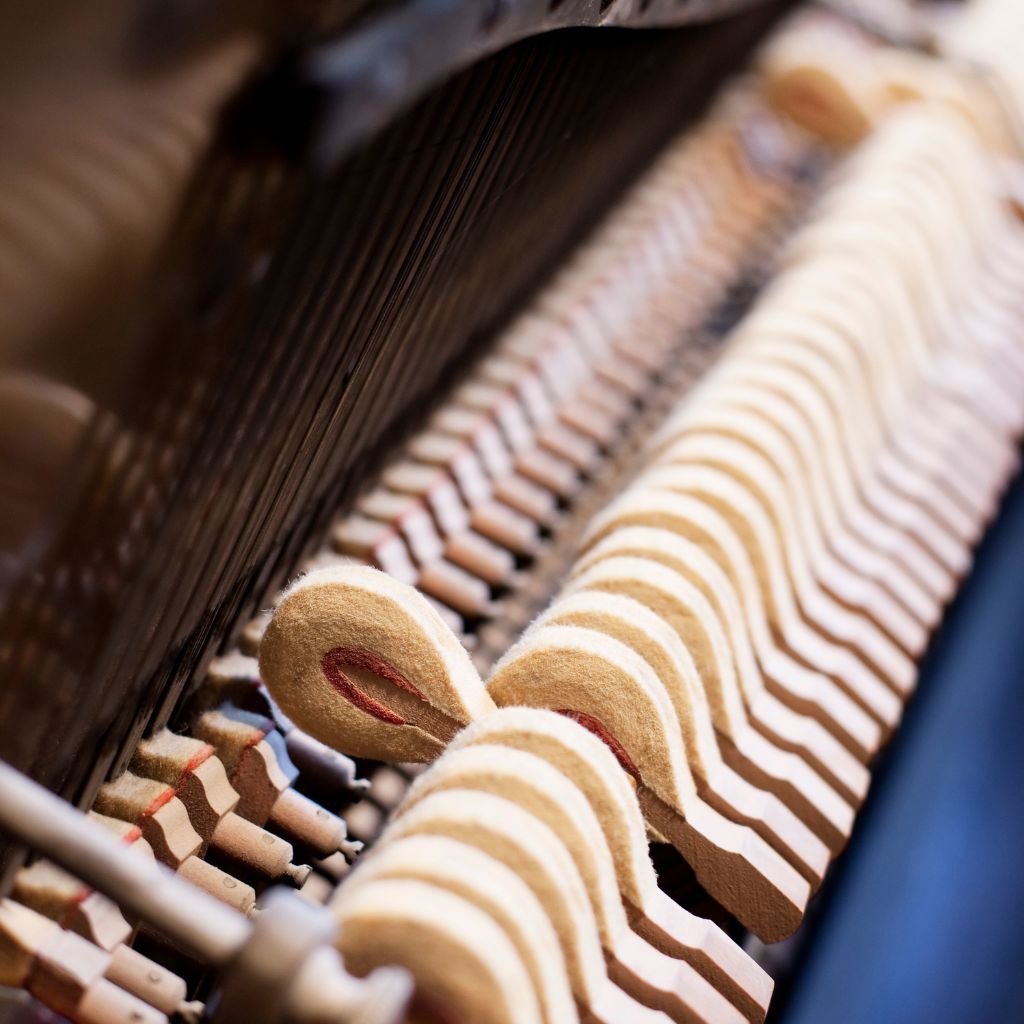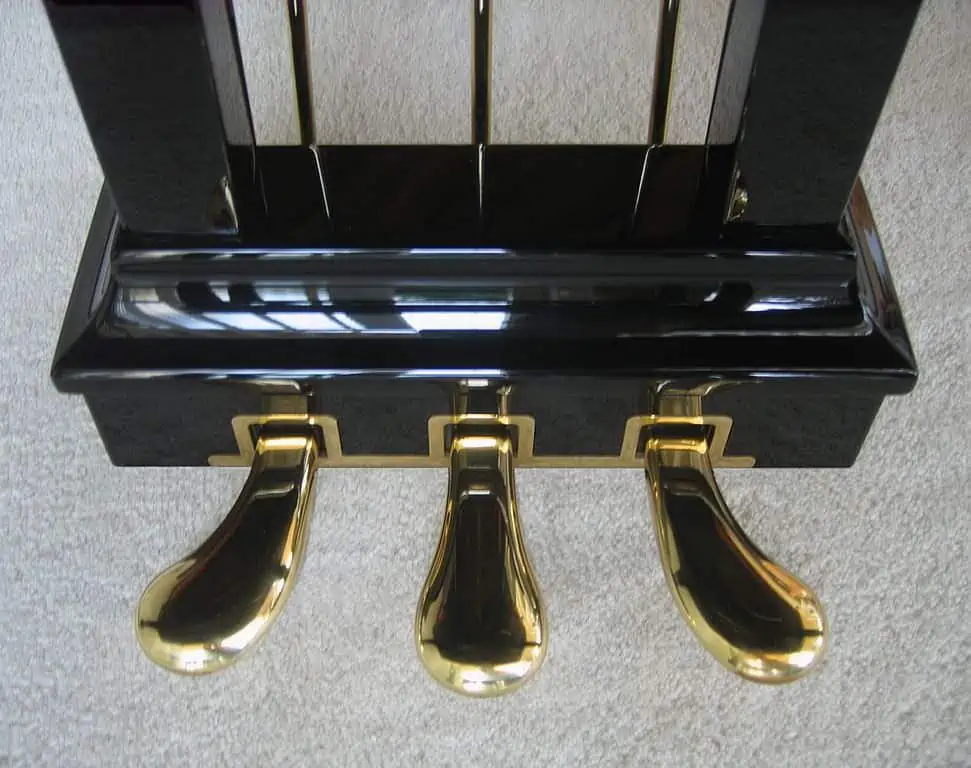Best
AFFORDABLE
UPRIGHT PIANO
Upright Digital Piano
by Gear4music OFFERS 40 AUTHENTIC SOUNDS
-
Overall: Upright Cabinet In Polished Ebony
-
Best Feature: With 256-Note Polyphony And
A Graded Hammer Action Keybed -
TedScore™: 9/10
Best
OVERALL
UPRIGHT PIANO
-
Overall: Provides Bright And Modern Sound With Full-Bodied Projection
-
Best Feature: Compact Cabinet For Easy Installation At Home
-
TedScore™: 9/10
Best
DIGITAL
UPRIGHT PIANO
-
Overall: SuperNATURAL Piano Modeling sound generator
-
Best Feature: PHA-4 Standard keyboard with high-resolution sensing
-
TedScore™: 9/10
Are you wondering, ‘How much does an upright piano weigh?’
You may have been planning to buy a studio piano for your home but are hesitant because you’re unsure if you can deliver it to your designated area.
Given its size and length, not to mention the material it was built with, an upright piano’s weight might be overwhelming.
Don’t worry! Keep reading, and we will definitely answer your question!
Electric pianos, on the other hand, are lightweight and portable alternatives, making them particularly suitable for beginners and performers who need mobility.
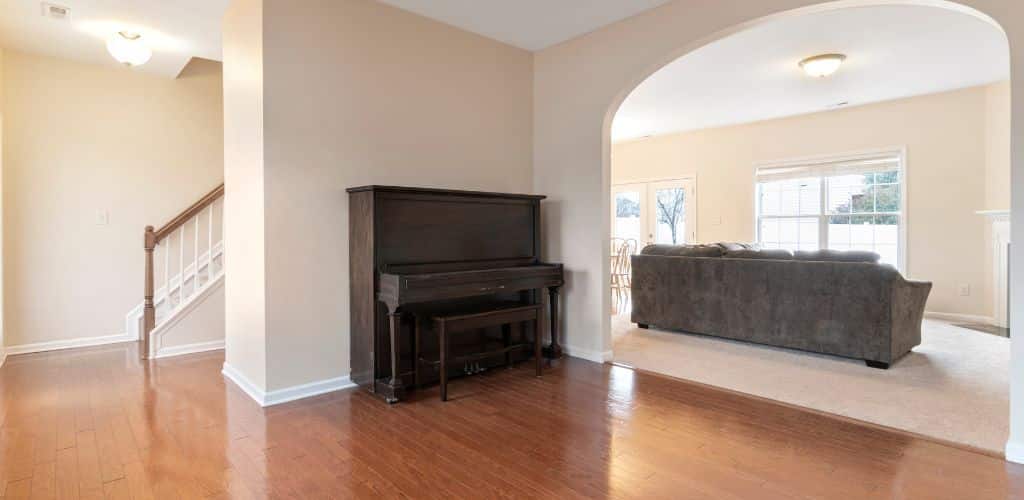
Pianos come in various shapes and sizes (Yep, just like humans!). Specifically, an upright piano is a compact powerhouse, where weight plays a crucial role in its construction and placement.
The typical upright piano weighs between 300 and 500 pounds. Such weight is a testament to the sturdy materials and intricate craftsmanship that go into each musical treasure.
Understanding Piano Weight
When it comes to pianos, weight is more than just a number—it’s a crucial factor that influences how you move, store, and maintain your instrument.
Whether you’re dealing with a compact upright piano or a grand piano, understanding its weight can save you a lot of hassle and potential damage.
Imagine trying to move a piano without knowing its weight. You could end up with strained muscles, damaged floors, or worse, a broken piano.
Knowing the weight helps you plan the logistics, from the number of people needed to the type of equipment required.
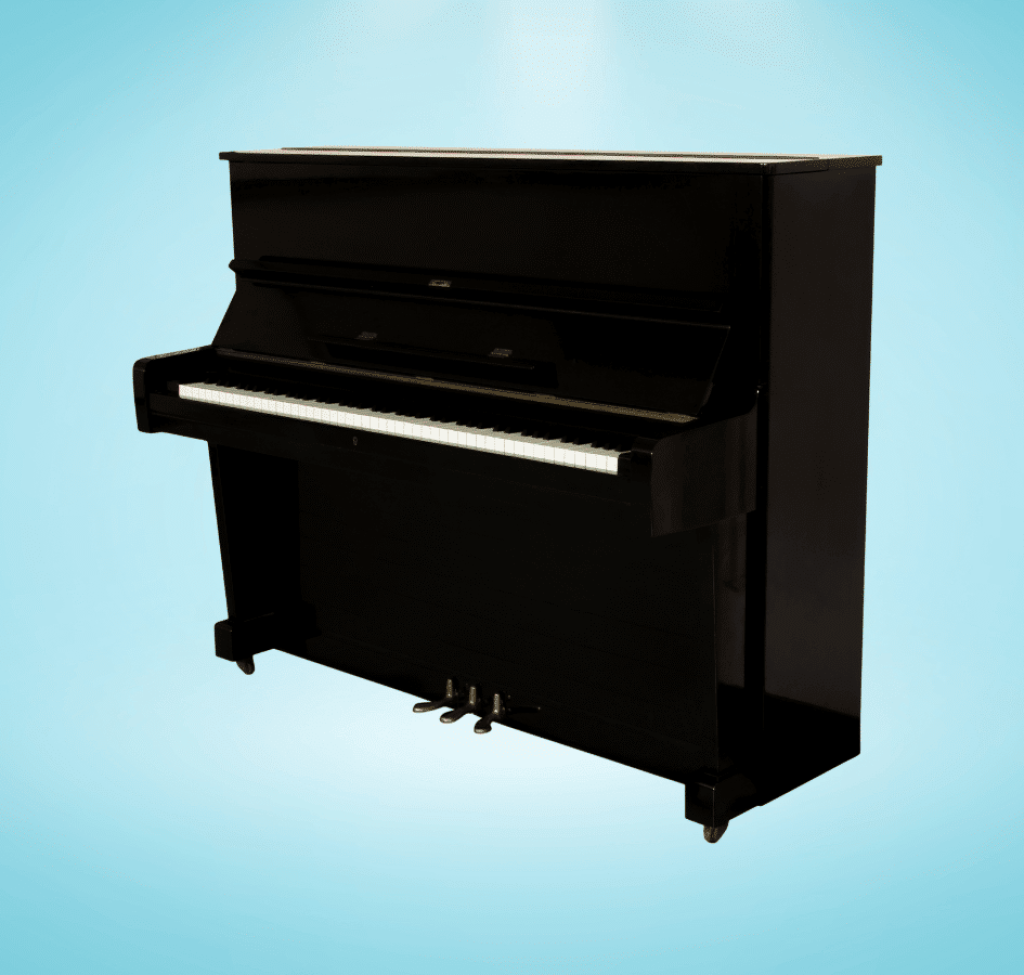
It also plays a role in storage; a heavy piano needs a sturdy, stable surface to rest on.
Moreover, the weight of a piano can affect its sound and performance. Heavier pianos often have larger soundboards and longer strings, contributing to a richer, more resonant sound.
So, when you’re considering a piano, its weight isn’t just a physical attribute—it’s part of its musical character.
Upright Piano Basics
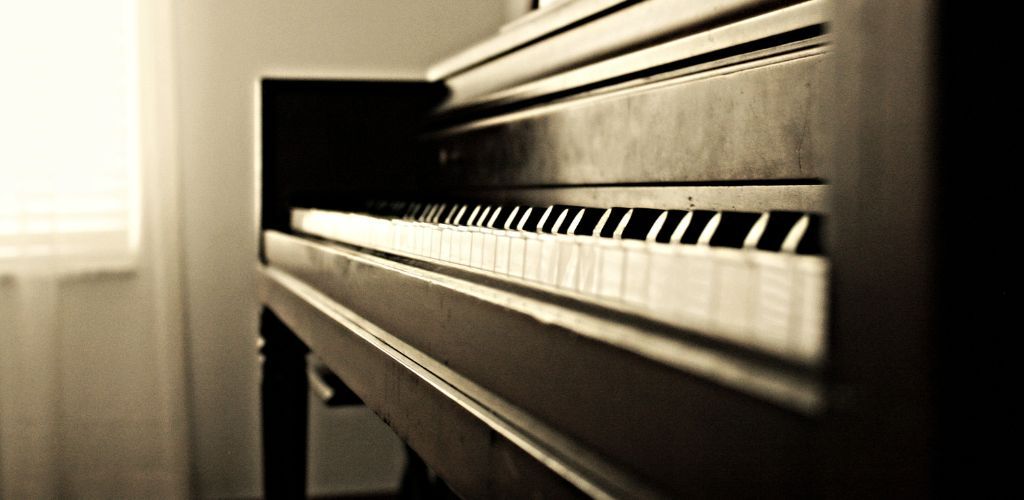
When you think of pianos, the grandeur of concert grand pianos, even baby grand pianos, might steal the spotlight, but the upright piano holds a special place in many homes.
They offer a more compact frame with a rich history and variety.
Types of Upright Pianos
Upright pianos, also known as vertical pianos, come in several sizes. When considering how much a piano weighs, it’s important to note the differences between these types.
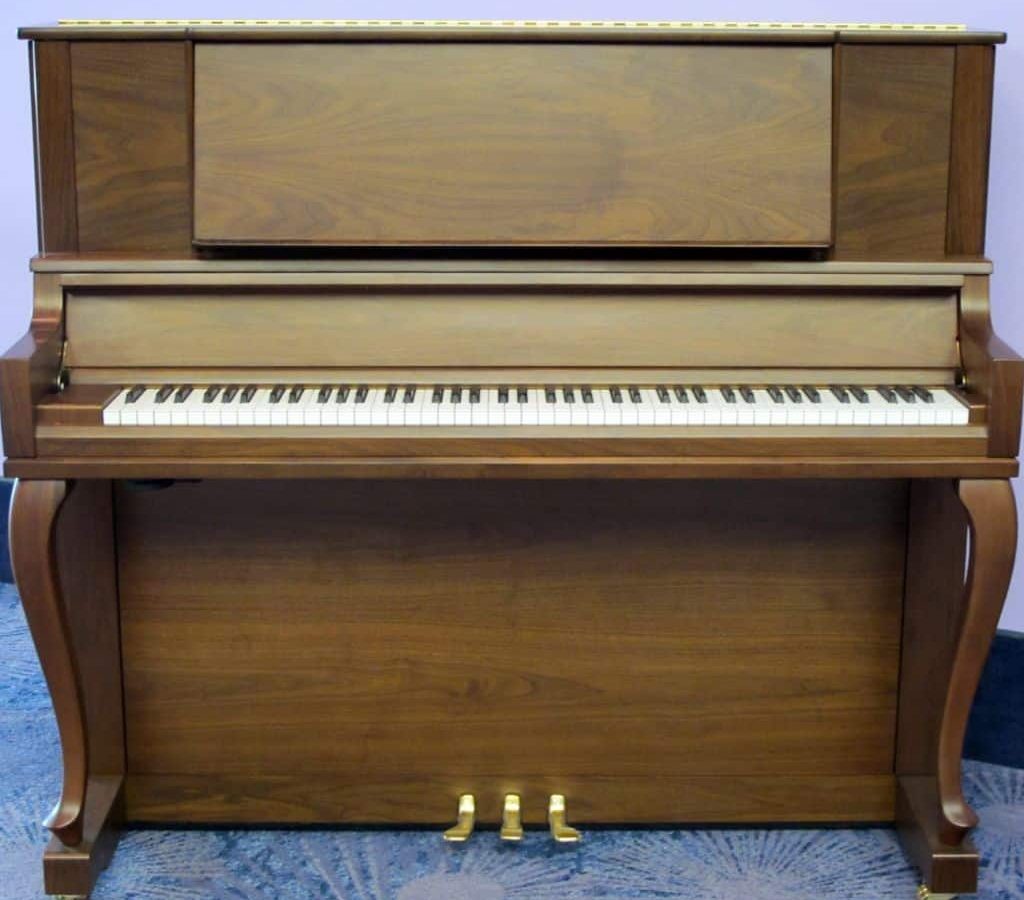
- The spinet piano is the smallest, usually about 36 to 40 inches tall.
- A console piano slightly increases in size, ranging from 40 to 43 inches.
- Studio pianos elevate size and sound with their 45 to 48-inch stature. Due to their durability and sound quality, they are commonly used in music education.
Each type caters to different needs, whether space constraints or musical quality.
Standard Upright Piano Dimensions
While the dimensions vary, a typical upright piano is approximately 58 inches wide and 24 inches deep.
However, the height can range from 36 inches (for a spinet) to about 48 inches (for a studio model).
This size allows for a significant soundboard and longer strings than most assume, contributing to the robust sound of an upright.
The dimensions are crucial in acoustics, with larger pianos generally producing a richer tone.
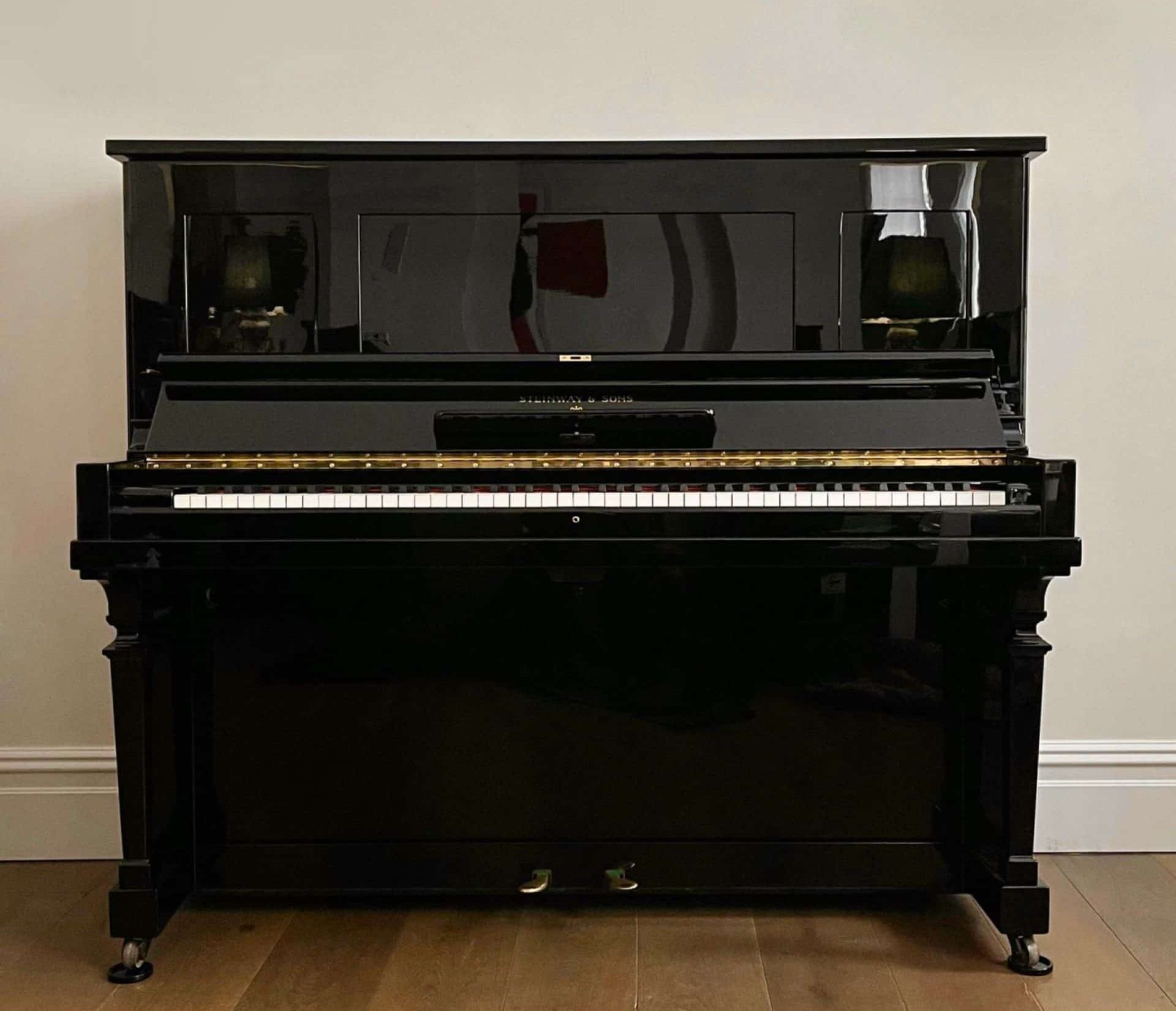
Weight and Transport of Upright Pianos
Imagine you’ve just inherited a beautiful upright piano, and now it’s time to make it the centerpiece of your living room.
To transport it, you’ll need to know its weight and how to move it without a single scratch.
Average Weight of Pianos and Upright Pianos
An average piano weighs anywhere from 300 to 1,200 pounds (136 to 544 kilograms).
Typically, an upright piano has a commanding presence and weighs 300 to 500 pounds.
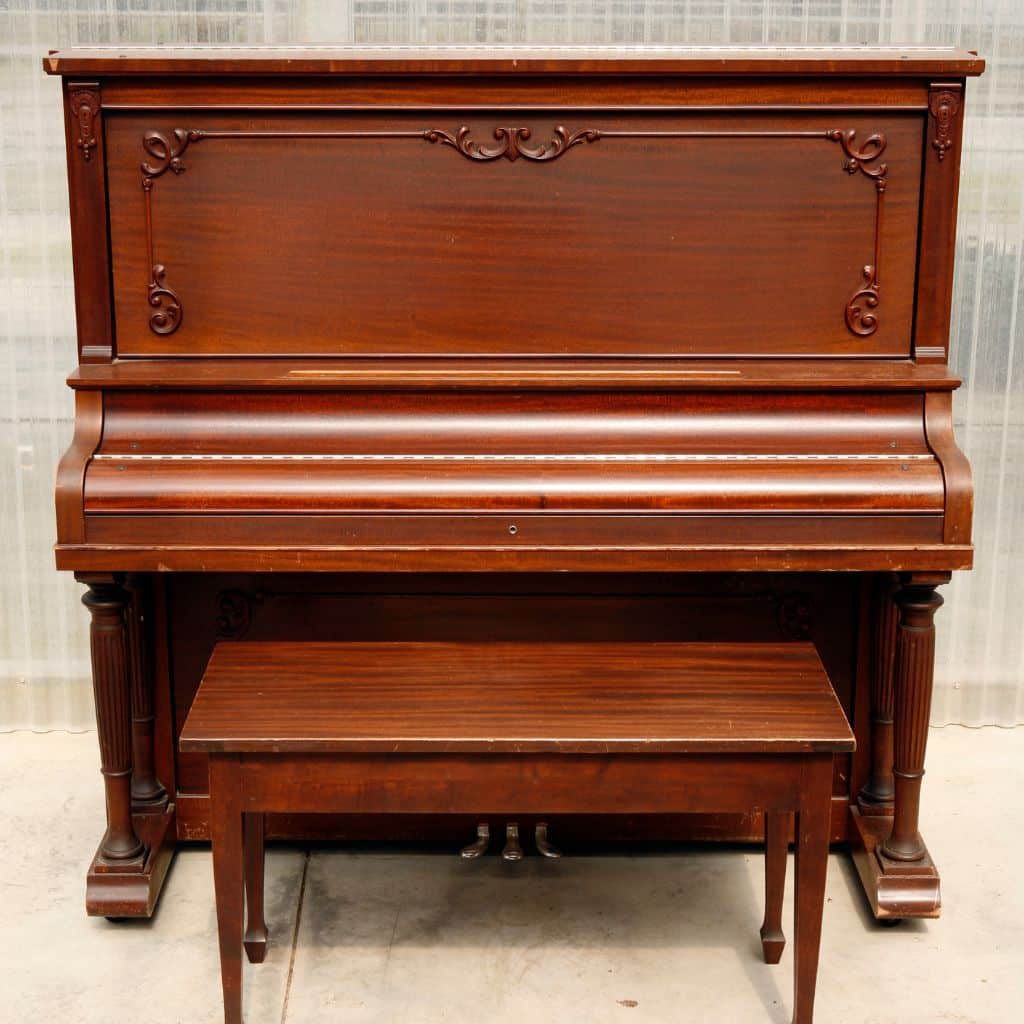
- Spinet pianos weigh between 200 to 300 pounds (90 to 136 kilograms).
- Console pianos weigh between 350 to 450 pounds (159 to 204 kilograms).
- Studio pianos weigh between 400 and 500 pounds (181 to 227 kilograms), and medium grand pianos weigh between 500 and 600 pounds (227 to 272 kilograms), making them heavier than upright pianos but still manageable in size and weight.
Moving an Upright Piano Safely
When it’s time to move your piano, enlisting a professional piano mover can help you!
They come equipped with tools like a piano skid board and moving blankets to cradle your piano during transit.
You can expect to pay a pretty penny for this service, with the cost to move a piano typically ranging from $150 to $600, influenced by the move’s complexity and distance.
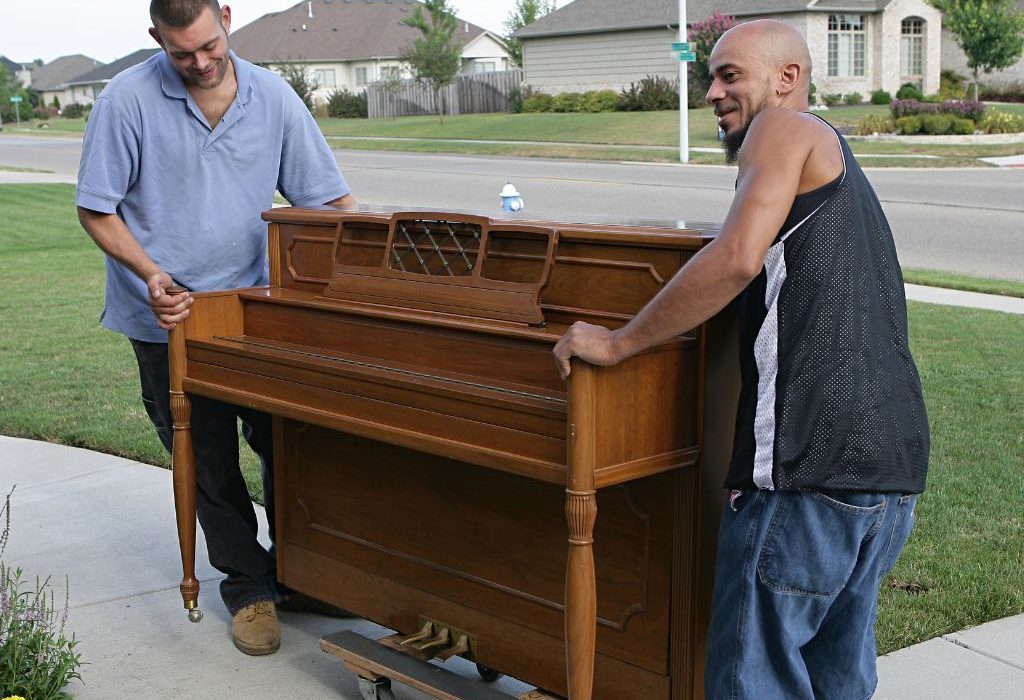
Factors Affecting
Piano Weight
Several factors contribute to the weight of a piano, making each one unique in its heft and sound. Here’s a closer look at what makes some pianos heavier than others:
The kind of wood used in a piano’s construction significantly impacts its weight. Hardwoods like maple and oak are denser and heavier than softer woods like pine. The quality and thickness of the wood also play a role.
The cast iron plate, or frame, is one of the heaviest components of a piano. Its size and thickness can vary, with larger, thicker plates adding more weight. This plate is crucial for withstanding the tension of the strings.
The number and type of strings also affect the weight. Pianos with more strings or thicker strings will naturally weigh more. The tension of these strings adds to the overall weight.
The soundboard, which amplifies the sound of the strings, can vary in size and weight. Larger soundboards contribute to a heavier piano but also produce a richer sound.
The design and materials of the piano’s frame and legs can add to its weight. Ornate, solid wood legs, and frames are heavier than simpler, more modern designs.
Understanding these factors can help you appreciate the craftsmanship that goes into each piano and why some models are heavier than others.
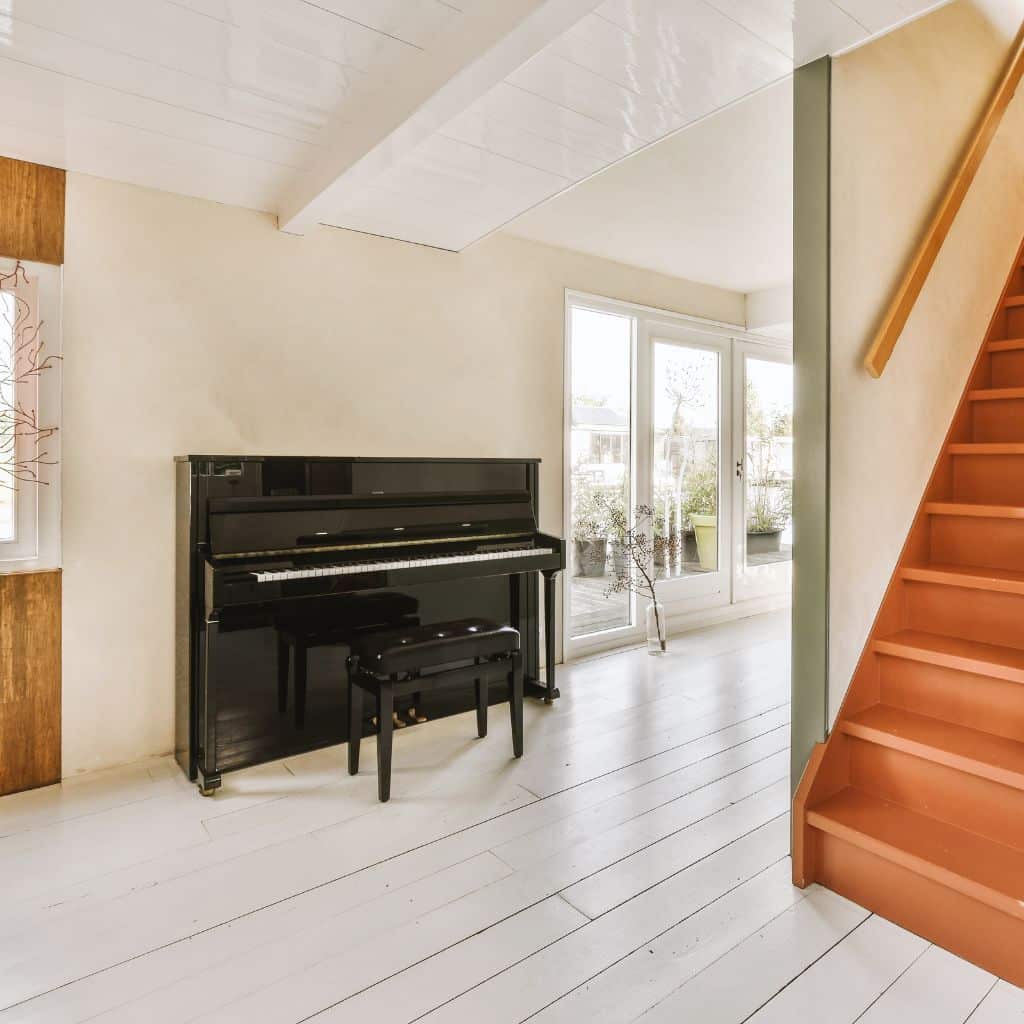
Comparison with
Grand Pianos

Your average upright invites space-saving without shortchanging the musical experience, and that’s just the beginning of the story.
Let’s compare the physical and weight differences of upright and grand pianos.
Physical and Weight Differences
An average professional grand piano’s length is from 4 feet 7 inches to over 9 feet long.
- The miniature grand piano (the small grand pianos!) length is 4 feet 7 inches (1.4 meters).
- The average baby grand piano length ranges from about 4 feet 7 inches to 5 feet 6 inches (1.4 to 1.68 meters).
- The medium grand piano measures 5 feet 7 inches to 6 feet 4 inches (1.7 to 1.93 meters) in length.
- The length of a semi-concert grand piano or ballroom grand piano is 7 feet, which is approximately 2.1 to 2.2 meters. Due to its bulkiness, the ballroom grand piano requires ample space, making it challenging to move and requiring careful placement planning.
- The concert grand piano length ranges from 9 feet to 10 feet (2.74 to 3.05 meters).
When it comes to weight, it’s a matter of scales.
An average upright can weigh approximately 300 to 500 pounds.
- Baby grand pianos weigh around 500 to 600 pounds.
- Medium grand pianos weigh between 500 to 700 pounds (227 to 318 kilograms). They are often called a “parlor grand piano” or “living room grand piano.”
- Semi-concert grand pianos weigh between 750 to 900 pounds (340 to 408 kilograms).
- A full concert grand piano or professional grand pianos weigh about 990 pounds.
Upright Pianos
I Love And Recommend
Yes, upright pianos weigh a lot! But this doesn’t mean you can’t check out and buy one, right?
Before we end this article, I’d like you to check out these brands and models of acoustic upright and digital pianos that I was able to try during my performances and studio rehearsals.
YAMAHA
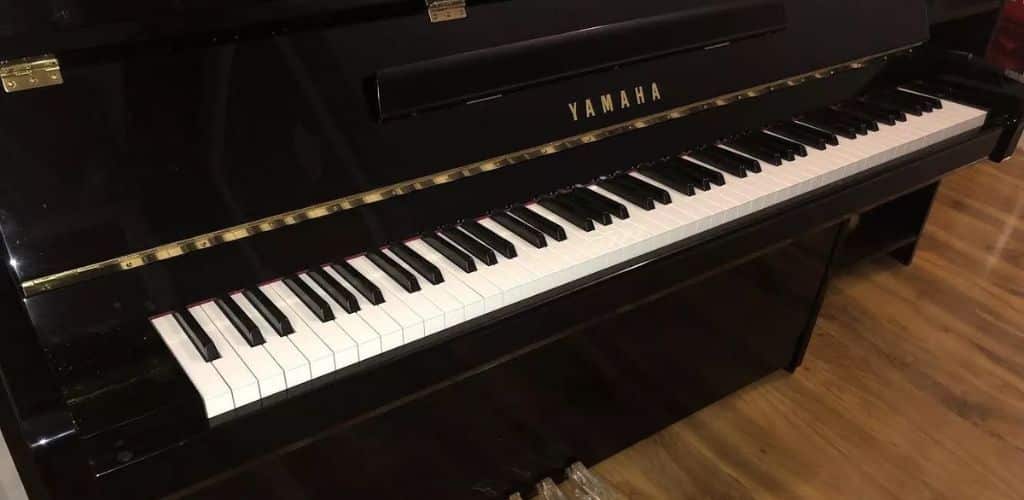
I recently purchased a Yamaha B1 Upright Acoustic Piano and am thoroughly impressed with its clear, resonant sound and the responsive touch of the keys.
Its compact size fits perfectly in my home, and the sleek design adds an elegant touch to my living space.
Yamaha B1 Upright Acoustic Piano, Natural Cherry Satin

PERFECT FOR: Student Musicians
FEATURES: Provides bright and modern sound with full-bodied projection
OTHER INFO: Compact cabinet for easy installation at home
Yamaha B1 Upright Acoustic Piano, Natural Cherry Satin
- Built with acrylic key tops for a comfortable feel
- Combines a modern and compact cabinet with a bright and contemporary sound
- Professionally crafted by the renowned company Yamaha
- None!
When you click ‘Check Price’, you’ll see there are loads of great places to buy this item. Our personal favorite is Sweetwater for the US, and Thomann and Gear4Music for the UK & Europe.
They are the largest music retailers, with excellent customer service, competitive prices, really fast shipping, and the longest guarantees.
The professional musician who wrote this article combined many things,
from the product build, manufacturer’s reputation through to feedback
from other users, to create our famous TedScore™.
ROLAND
I’ve been playing the Roland HP702 Digital Upright Piano for a few months now, and I’m really pleased with its rich, expressive sound and the dynamic touch of the PHA-4 keyboard.
The various features, including Bluetooth connectivity and built-in educational tools, make it a versatile instrument that’s enjoyable and convenient for practice and performance.
Roland HP702 Digital Upright Piano
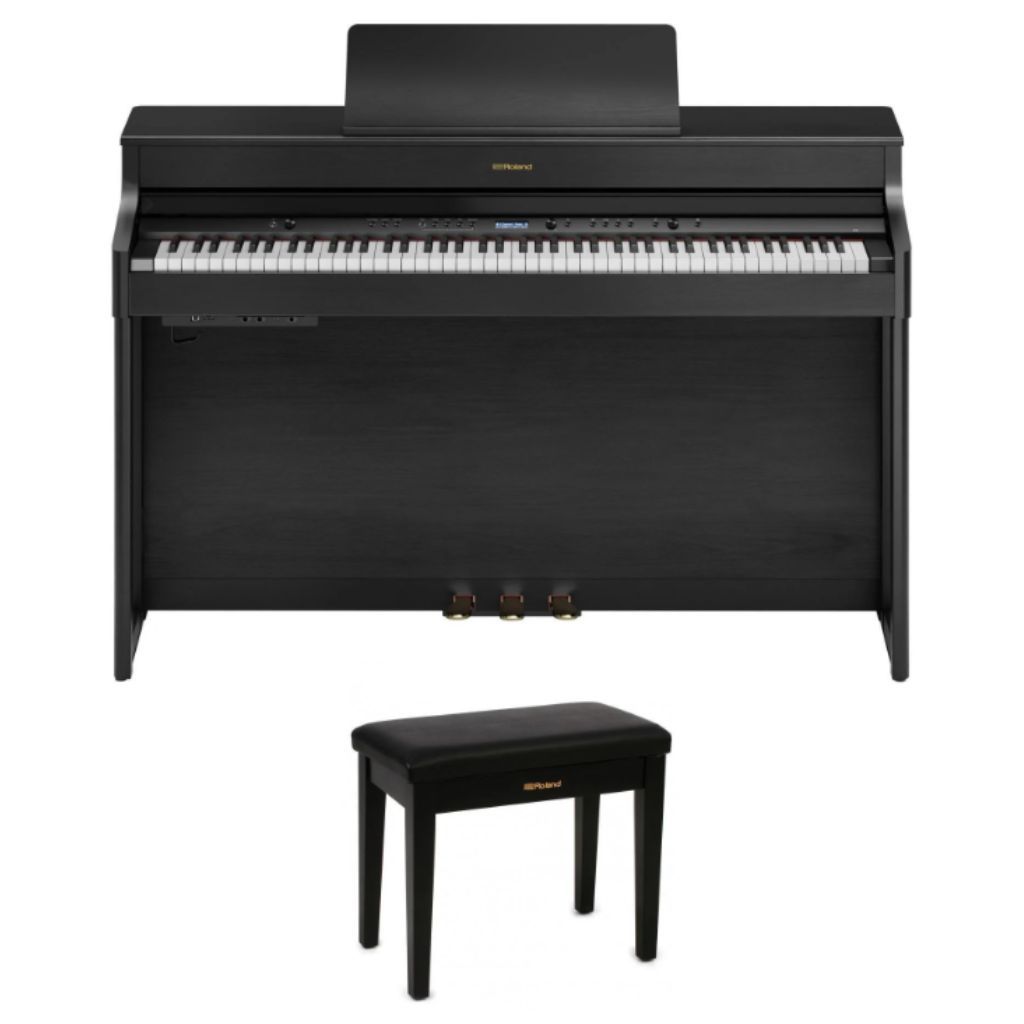
FEATURES: SuperNATURAL Piano Modeling sound generator
OTHER INFO: PHA-4 Standard keyboard with high-resolution sensing
- Authentic acoustic piano touch and feel due to the weighted keyboard
- High-quality, realistic piano sounds with SuperNATURAL technology
- Higher price point compared to some entry-level digital pianos
When you click ‘Check Price’, you’ll see there are loads of great places to buy this item. Our personal favorite is Sweetwater for the US, and Thomann and Gear4Music for the UK & Europe.
They are the largest music retailers, with excellent customer service, competitive prices, really fast shipping, and the longest guarantees.
The professional musician who wrote this article combined many things,
from the product build, manufacturer’s reputation through to feedback
from other users, to create our famous TedScore™.
GEAR4MUSIC
After playing the DP-90U Upright Digital Piano by Gear4music, I’m delighted with its realistic weighted key action and the quality of its various instrument voices.
It’s a great value for its price, providing a satisfying playing experience for both practice and performance in a stylish, space-saving design.
DP-90U Upright Digital
Piano by Gear4music
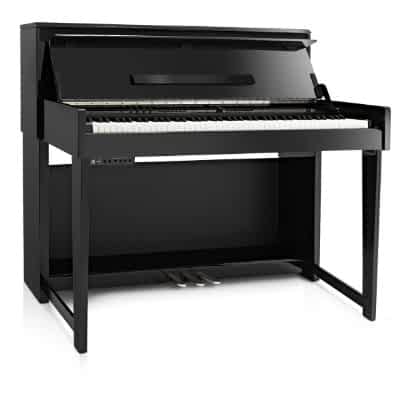
PERFECT FOR: Beginners and advanced players
FEATURES: Upright cabinet in polished ebony
OTHER INFO: With 256-note polyphony and a graded hammer action keybed
DP-90U Upright Digital
Piano by Gear4music
- USB connectivity is supported.
- Suitable for self-study/home learning
- None!
When you click ‘Check Price’, you’ll see there are loads of great places to buy this item. Our personal favorite is Sweetwater for the US, and Thomann and Gear4Music for the UK & Europe.
They are the largest music retailers, with excellent customer service, competitive prices, really fast shipping, and the longest guarantees.
The professional musician who wrote this article combined many things,
from the product build, manufacturer’s reputation through to feedback
from other users, to create our famous TedScore™.
Piano Maintenance
and Weight

Maintaining a piano is essential for preserving its sound and longevity, but did you know that maintenance tasks can also affect its weight? Here’s how:

Regular tuning is necessary to keep a piano sounding its best. However, tightening the strings during tuning can slightly increase the piano’s weight.
While this change is minimal, it reminds us of the tension and forces at play within the instrument.
Major maintenance tasks, such as replacing the soundboard or cast iron plate, can significantly alter a piano’s weight.
These components are heavy, and swapping them out can make the piano lighter or heavier, depending on the replacements used.
When performing maintenance, it’s crucial to consider the weight changes to ensure the piano remains properly supported and balanced. This attention to detail helps maintain the piano’s structural integrity and sound quality.
By understanding these aspects of piano weight, you can better care for your instrument, ensuring it remains a beautiful and functional centerpiece in your home for years to come.
How Much Does an Upright Piano Weigh:
It Weighs A Lot!
An upright piano typically weighs between 300 and 500 pounds.
How such a hefty instrument can produce those delicate tunes you love is a marvel. But hey, don’t worry—moving it won’t magically turn you into a weightlifter!
You’ll find sleek, smaller acoustic pianos hovering around 300 pounds. The larger ones strike a pose at about 500 pounds, standing proud as your room’s acoustic centerpiece.
- The Spinet piano weight is 200 to 300 pounds (90 to 136 kilograms). Its dainty frame (36 to 38 inches tall) makes it your space-saving buddy.
- The Console piano weighs 350 to 450 pounds. It’s a step up in height (40 to 43 inches) and weight, offering a richer sound.
- The Studio piano weight is 400 to 500 pounds (181 to 227 kilograms). (45 to 47 inches), a hit in music schools for its durability and tonal quality.
- The Professional Upright piano weight is 500 to 600 pounds (227 to 272 kilograms). It’s the tallest (48 to 60 inches) among the vertical and upright pianos—a real concert performer.
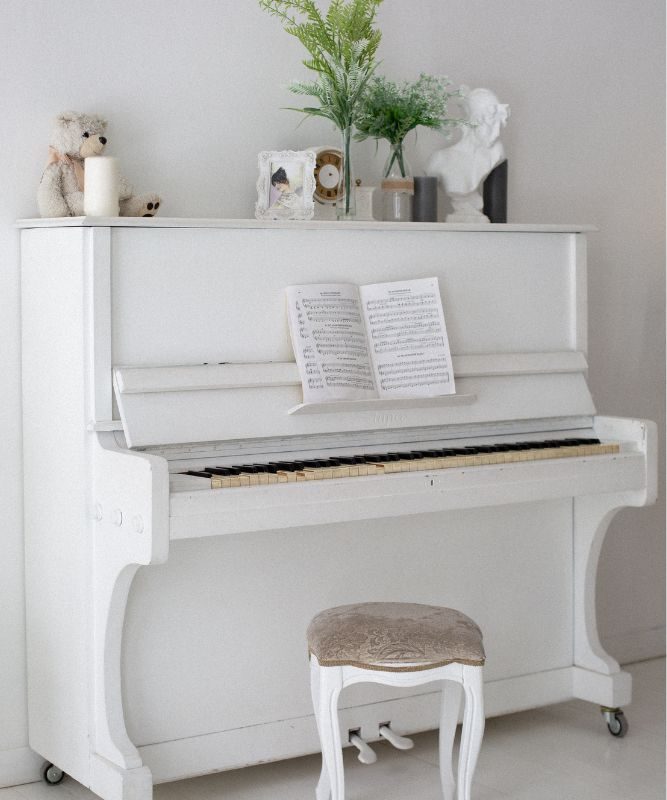
So, there you have it! Your piano’s weight is part of its charm!
Wait! Just a few more…
Now that you know the weight of the different piano sizes, check this next article to know how to buy one. This will be your helpful guide in buying one. Enjoy!
FAQ's
An average upright piano typically weighs between 400 and 500 pounds (181 to 227 kilograms), but the exact weight can vary depending on the model and construction materials used.
Moving an upright piano by yourself is not recommended due to its weight and the risk of injury or damage to the instrument. If it must be moved, use a piano dolly and secure the piano with straps, but ideally, seek assistance from professional movers who specialize in handling pianos.
Depending on its size and weight, an upright piano typically requires at least three to four people to move safely. Professional piano movers are trained to handle the task efficiently and use the proper equipment to prevent injury and damage.
A 100-year-old upright piano generally weighs roughly the same as modern upright pianos, between 400 to 500 pounds (181 to 227 kilograms). However, the weight can vary depending on the specific make, model, and materials used in the early 20th century.



